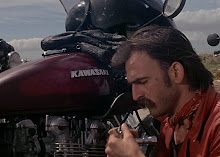... Except the turbo...
... Maybe...
Anyway, let's break out the tools and get dirty. First we'll have a look at the clutch lifter area as it comes from Triumph:
Yuck! That looks terrible. The only way to fix that is to add some chrome. As they say, if it don't go, chrome it!
The first step is to remove the bracket holding the clutch cable to the clutch cover. Loosen up the nuts on the cable with a pair of 12mm wrenches and then remove the two 8mm bolts. With that loose, you can now wiggle the clutch cable out of the lifter arm. When you do this, the arm will slacken and move backward. Don't worry because it will very easily go back into position.
With the cable in your hand, spin off the nut facing the rear of the bike and remove the bracket. Slide the new awesome chrome bracket on, install the nut and then the rubber boot, slip the cable back into the lifter arm and bolt up the bracket. The new bracket is thicker than the old one but there are plenty of threads on the bolts.
For the lifter arm cover, remove the two hex screws on the cover and apply thread locker to the threads. This will prevent the little screws from vibrating out. I used hi-temp thread locker because it does get hot down there. Slip the cover over the arm and install the screws one at a time. Tighten until they're snug.
Once completed, it should look like this:
Oh, hang on. It should look like this:
Yes, that looks more better. The chrome adds a bit of bling to an otherwise dull area of the bike. Readjust the clutch cable and that job is finished.
Next up is the rectifier.
The standard rectifier on the Bonnie runs hot and does an alright job. This is an area that could be better and a MOSFET rectifier is a big improvement. This will strengthen the charging system while running much cooler than stock, meaning increased life for the unit. I chose a Hotshot rectifier from Rick's Motorsport Electrics.
When I took it out of the box, it looked huge and I didn't think it would fit in the stock location. Comparing it the stock unit, however, shows it's actually smaller:
To begin, remove the headlamp and gaze into the mess of wiring behind it. Somewhere in there is the connecter for the rectifier.
Once you've found it, wiggle it out of the bucket and remove the two 8mm bolts holding the stock unit in place. To install the new unit, first wiggle the connecter into the bucket. Next, install and tighten the two 8mm bolts. As you can see in the pic with the two units, the new one is narrower than stock. There is enough room, thankfully, to bolt the new unit in place. once the rectifier is secure, apply some dielectric grease to the terminals and plug it in. Install the headlamp and let's fire up the engine.
At normal idle with the standard rectifier, here is the charging voltage:
That's quite an improvement. The battery likes it, too, because it's holding voltage a lot better than it did with the stock rectifier.
And that's that. Go grab yourself a celebratory beer, coffee or whatever and stand back and admire your work.







